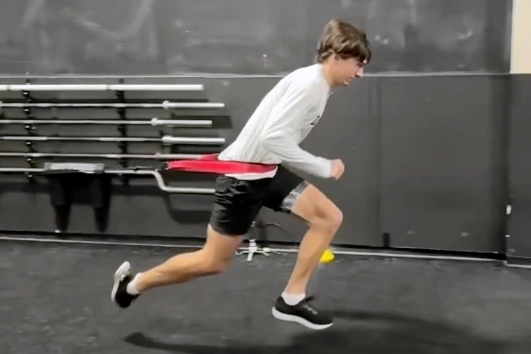Unlocking Speed: The Power of Acceleration Training

In the world of sports, the difference between good and elite often comes down to milliseconds. Whether it’s a basketball player driving past a defender, a football receiver breaking off the line, or a sprinter exploding from the blocks, one quality consistently sets top athletes apart — acceleration.
Acceleration is an athlete’s ability to initially build speed and create separation from their competition. It’s that explosive first step, the burst that puts an opponent on their heels, and the physical advantage that often dictates the outcome of a play. Training to enhance acceleration isn’t just about moving fast — it’s about developing the skill of speed under game-like conditions.
The Building Blocks of Acceleration
To effectively improve acceleration, athletes need to develop more than just raw speed. Acceleration is a coordinated display of mobility, power, and mechanical efficiency — all working together in milliseconds.
1. Mobility for Power Angles
One of the most overlooked aspects of acceleration is ankle mobility. Without adequate mobility through the ankle joint, athletes struggle to produce the horizontal force needed to push their body forward at a low angle. When ankle mobility is limited, power leaks upward or vertically — reducing drive and creating inefficient movement. By improving ankle range of motion, athletes unlock optimal force angles that directly translate to speed off the line.
2. Horizontal Power Production
Power isn’t just about jumping high or lifting heavy — it’s about applying force in the right direction. In acceleration, that means horizontal force. Developing power through resisted sprints, sled pushes, and plyometrics aimed at hip displacement helps athletes build the explosive thrust necessary to propel their body forward quickly. The more force an athlete can put into the ground behind them, the faster they accelerate.
3. Mechanics That Match the Moment
Even the strongest athletes won’t accelerate well if their mechanics are flawed. Acceleration mechanics rely on forward body angles, aggressive shin position, and most critically, movement driven through the hips — not from cycling or lifting the knees early. Athletes must learn to “stay low and push long,” avoiding an upright posture that prematurely shifts them into top-end sprinting mechanics. True acceleration is about projecting forward, not just moving quickly.
Drills That Drive Results
Improving acceleration takes more than just running fast — it requires intentional, well-designed drills that target each element of the acceleration process. At PR Strength, we use a mix of resisted movement, technical drills, and data feedback to sharpen every athlete’s first steps.
1. Loaded Sled Marches
This drill is a staple in our program because it builds both strength and motor control in the exact positions athletes need for acceleration. By marching under load, athletes are forced to maintain optimal shin angles, posture, and hip extension patterns. The sled resists poor mechanics and rewards strong, deliberate force into the ground. It’s a slow drill that trains fast results.
2. Load-Lift-Switch Drills on the Wall
Wall drills give athletes a tactile reference for body lean and posture during acceleration. The load-lift-switch sequence trains rhythm, coordination, and the timing of hip displacement. It’s not just about getting the leg up — it’s about driving it back down with purpose. We coach athletes to move through the hips and feel the difference between “cycling” versus projecting forward.
3. Timed Short Sprints with Valid Timing Gates
One of the most powerful tools in our system is objective feedback. By using Vald timing gates during 5–10 yard sprints, we can show athletes in real-time how adjustments in form impact performance. Whether it’s foot placement, body angle, or arm mechanics, precise timing helps us take the guesswork out of speed work. We make small changes, test, and repeat — turning speed into science.
Progressive Acceleration: From Fundamentals to Game Speed
At PR Strength, acceleration training isn’t static — it evolves as the athlete does. Once foundational movement patterns and mechanics are established, we introduce layers of complexity and intensity that mirror the demands of sport.
Building on the Base
As athletes progress through our system, we introduce plyometrics to enhance elastic power, dynamic effort-based strength training to build speed-strength, and a progressive speed development plan tailored to their needs. These methods are layered with intent — always reinforcing the qualities of forward projection, hip-driven movement, and efficient mechanics under pressure.
From the Lab to the Game
By the end of a cycle, athletes aren’t just moving better in drills — they’re exploding past defenders, getting to the ball first, and executing with confidence. Our system isn’t built on hype — it’s built on repeatable results and continuous progression.
Train With Us
Whether you’re a youth athlete just starting to build your foundation or a pro looking to sharpen your edge, PR Strength can help you accelerate your development — literally.
Want to learn how?
Reach out today to discover how our acceleration training can help you create separation from your competition. Call me at (301) 635-5789 or send an email to team@prstrengthtraining.com.
Coach Reeves
PR Strength
Ready to Get Stronger, Faster, Better?
Connect with PR Strength!
Sign up to get expert tips, training insights, and exclusive offers from PR Strength!
